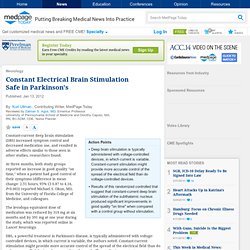

Gladstone Scientists Identify Protein that Contributes to Symptoms of Parkinson's Disease. New research reveals how alpha-synuclein interacts with cell membranes in Parkinson's disease. The accumulation of α-synuclein, a small, negatively charged protein, in neural cells, is one of the hallmarks of Parkinson's disease.

It has been suggested that oligomeric α-synuclein causes membranes to become permeable, or to form channels on the outer cell membrane. Now, a group of scientists from Sweden has found a way to reliably replicate α-synuclein aggregation on cell membranes to investigate how different forms of α-synuclein interact with membranes under different conditions and to learn if any of the α-synuclein species can penetrate these membranes. Their results are published in the current issue of the Journal of Parkinson's Disease. "We found that on-pathway oligomers and α-synuclein fibrils associate with negatively charged model membranes. "On-pathway oligomers are difficult to isolate and enrich due to their dynamic nature.
More information: The article is "Membrane Interaction of α-Synuclein in Different Aggregation States," by M. Researchers identify path to treat Parkinsons disease at its inception. EAST LANSING, Mich. — Imagine if doctors could spot Parkinson’s disease at its inception and treat the protein that triggers it before the disease can sicken the patient.

A team of researchers led by Basir Ahmad, a postdoctoral researcher at Michigan State University, has demonstrated that slow-wriggling alpha-synuclein proteins are the cause of aggregation, or clumping together, which is the first step of Parkinson’s. The results are published in the current issue of the Proceedings of the National Academy of Sciences. Proteins, which are chain molecules composed of amino acids, do most of the work in cells. While scientists understand how proteins are structured, they do not yet know how they are built – a process known as folding.
When errors happen in folding, proteins clump together, form plaques such as those found in Parkinson’s disease, Alzheimer’s and Lou Gehrig’s disease, and cause cells to degenerate. Yujie Chen, MSU graduate student, was one of the co-authors of the paper. Constant Electrical Brain Stimulation Safe in Parkinson's. Constant-current deep brain stimulation (DBS) increased symptom control and decreased medication use, and resulted in adverse effects similar to those seen in other studies, researchers found.

At three months, both study groups reported an increase in good quality "on time," when a patient had good control of their symptoms (difference in mean change: 2.51 hours, 95% CI 0.87 to 4.16, P=0.003) reported Michael S. Okun, MD, from the University of Florida College of Medicine, and colleagues. The levodopa equivalent dose of medication was reduced by 319 mg at six months and by 391 mg at one year during the study, which was reported online in Lancet Neurology. DBS, a powerful treatment in Parkinson's disease, is typically administered with voltage-controlled devices, in which current is variable, the authors noted. To close this gap in knowledge, the investigators undertook an open-label, randomized, multicenter study. There were five cases of infection and four of intracranial hemorrhage. New study supports view that Lewy bodies are not the primary cause of cell death in Parkinson's Disease.
Civitas Therapeutics Announces Positive Results from Clinical Study of CVT-301, an Inhaled L-dopa for Parkinson's Disease. Ceregene Drug Fails in Parkinson’s Trial.